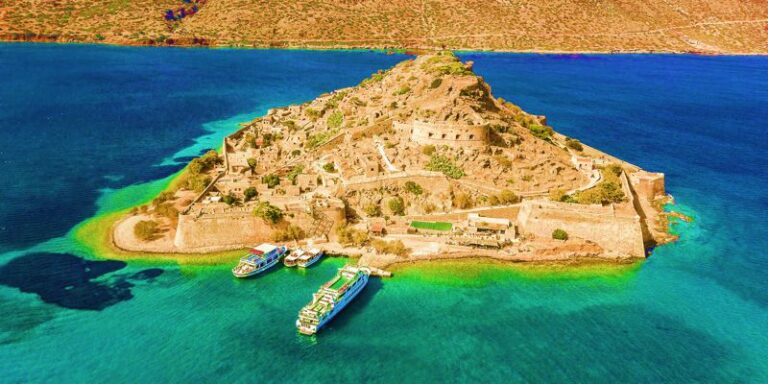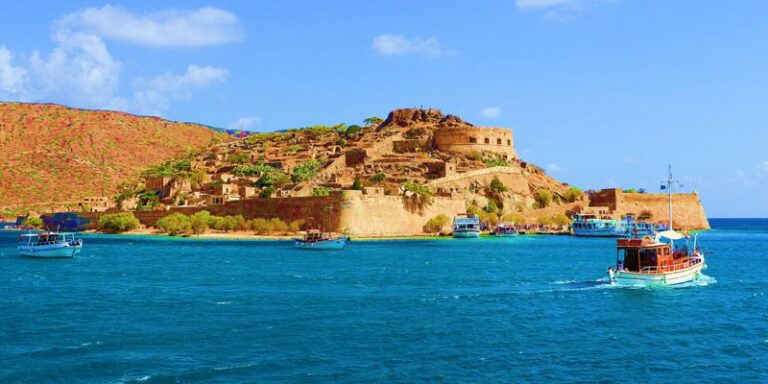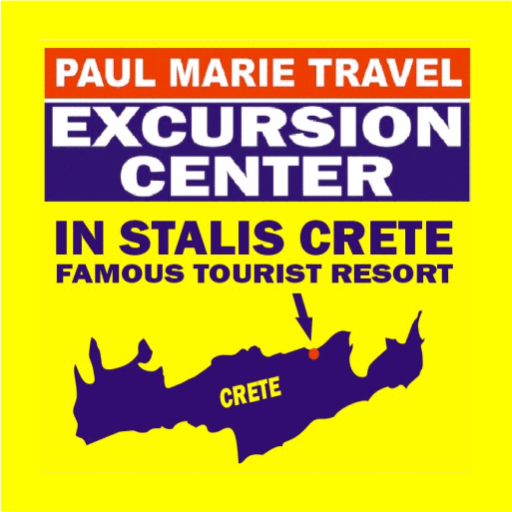SPINALONGA ISLAND TOUR


Full Day Trip - Bus Tour to Spinalonga Island, Agios Nikolaos, and Elounda
SPINALONGA ISLAND TOUR
DESCRIPTION
Spend the unforgettable day in one of the most beautiful areas of Crete! You will enjoy a boat trip along the picturesque gulf of Mirabello, a fascinating tour of the miniature Spinalonga island and swimming in Kolokitha Bay.
We will drive to the east of the island, pass through the gorge of St. George, and turning to the north, reach the one of the most popular and luxurious resorts of Crete – Elounda.
From there we will take a boat and sail to the island of Spinalonga, where you will have a guided tour, during which you will get acquainted with centuries-old history and culture of the island.
Ending the walk around the fortress, we will continue our boat trip to Kolokitha bay where you will have time to swim in the crystal clear waters of the bay.
Returning to Elounda, we will have enough time to discover the town and have lunch in one of local taverns. After that we will get on the bus once again and head to the picturesque town of Agios Nikolaos. Walking along its promenade and relaxing in one of the coffee shops located around the famous bottomless lake, will be a perfect end of this beautiful day.
Price
- Children 5-12 years old – 50%
- Children 0-4 years old – free
- call us for latest discounts
DAYS: Every Day
Pick-up & Drop-off Time:
NOTE: The pick-up and drop-off time can be changed during the season.
The correct pick-up time will be shown on your ticket.
The drop-off time is approximate and delays can occur.
Things to See and Things to Know
Spinalonga is a small rocky island with an area of 8.5 hectares located in the Gulf of Elounda in north-eastern Crete in the Lasithi prefecture of Crete, opposite of a small fishing village called Plaka. Its position at the mouth of the natural port of Elounda, along the picturesque gulf of Mirabello, made Spinalonga an island of great strategic location. It was fortified and served a variety of roles and purposes over the centuries… Back in 1574 started as a Vetetian fotress in order to protect the Elounda bay from the Turkish invasion. In 1905 it started to be used as a leper sanatorium until 1957, after this the cure was found and people where aloud to go back home.
Today, the uninhabited island of SPINALONGA is a popular tourist attraction in Crete. In addition to the abandoned leper colony and the fortress, Spinalonga is known for its small pebble beaches and shallow waters in nearby Kolokitha bay. The island can easily be accessed from Plaka, Elounda and Agios Nikolaos.
The history of SPINALONGA still inspires awe. It has been a Venetian fortress, a castle colony,
a rebel refuge, a place of exile for lepers, a communication link with Cairo during the Second World War. The island has been well fortified by the Venetians during their presence in Crete. From structural and architectural point of view and from an aesthetic view of the whole landscape, the island still retains an unsurpassed beauty.
# Departure from Heraklion/Gouves/Analipsi/ Anissaras/Hersonissos/Stalis/Malia
# Arrival at Elounda
# Boat departure to Spinalonga
# Arrival at Spinalonga island. 1 ½ hour stop and guided tour This tour takes us around the remains of this much-afflicted island and guides us through the pages of its history
# Stop for refreshing swim in the crystal clear waters of Mirabello Bay.
# We board the boat that takes us back to Elounda, from where we will take our bus to Agios Nikolaos
# Arrival at Agios Nikolaos. Free time for shopping and Relaxation.
# Approx return time back to Heraklion/Gouves/Analipsi/Anissaras/
Hersonissos/Stalis/Malia.
Different time pickups in different areas like Heraklion, Kokkini Hani, Gouves, Analipsi, Anissaras, Stalis and Malia. If you have difficulty in finding your pickup point, please contact us.
Click below for more info regarding each area pick-up service:
- Bus transfer
- Boat tickets
- Guided tour
- Food
- Entrance to Spinalonga island – €8
Entrances are free for:
Сitizens of other Member – States of the European Union who are over 65 years old, upon presentation of their ID card or passport for verification of their age and country of origin.
University students and students at Technological Educational Institutes or equivalent schools from countries outside the EU by showing their student ID
University students and Students of Higher Education Institutes, Technological Educational Institutes, Military Schools or equivalent Schools of member states of the European Union, as well as Schools of Guides, upon presentation of their student identity card
Young people, under the age of 18, after demonstrating the Identity Card or passport to confirm the age
For the availability for Last Minute Bookings (less than A WEEK before the starting hour of the tour) must first be checked by phone (+30) Greece 2897033678 or (+30) Greece 6977371826
In antiquity the island was walled to protect the ancient city of Olous. In the late 16th century, the Venetians built one of the most important defensive sea fortresses in the Mediterranean within the context of the major fortification works they carried out to defend Crete. Construction, based on the designs of the engineer Genese Bressani, began in 1579, and the initial building phase lasted until 1586. Repairs and alterations to the fortress were carried out both before and during the Cretan War (1645-1669). The fortifications consisted of two zones: the first followed the coastline, and the second was founded on the rocky ridge of the hill. Two transverse wall sections, on the southwest and the northeast of the islet, connected the two zones. The Μichiel mezzaluna and Moceniga mezzaluna (or Barbariga), important examples of fortification architecture, were situated at strategic points along the fortifications. During the Cretan War refugees and rebels (haïnides) took refuge here and harassed the Turks, using the islet as their base. With the treaty of the surrender of Candia (1669), Spinalonga remained a Venetian possession. In 1715 the islet was surrendered to the Turks following a siege. The Venetian garrison withdrew, and the remaining 600 or so inhabitants were taken prisoner. Muslims settled on Spinalonga from 1715, and they built their houses atop the foundations of Venetian buildings. The Muslim settlement was initially isolated and inaccessible, with around 250 inhabitants in the early 19th century. After the mid-19th century, the settlement experienced a heyday accompanied by urban evelopment. In 1881, the resident population reached 1,112 and the island operated as the largest Muslim trading center of Mirabello. The settlement’s buildings developed incrementally throughout the western and southern sides of the islet. In the late 19th century, it is estimated that there were around 200 residents on Spinalonga and 25 shops or workshops. A fair number of well-constructed two-storey houses and shops continue to be preserved today. Their building’s plasticity and symmetrical proportions recall the principles of local and Balkan architectural traditions. In 1903, the Cretan State established a leper colony on the island; its first 251 patients settled there in 1904. Originally, lepers coming only from Crete were deported here. But after 1913, when the island became part of Greece, lepers from the rest of the country also came to Spinalonga. The state was obliged to provide an allowance to each patient. The leper colony had a physician-director, nursing personnel, caretaker, financial department, and a priest. The ill resided in alreadyexisting buildings in the settlement as well as in modern buildings constructed during the 1930s. Patients lived independently in their own space, and were responsible for earning their livelihood. The limitations imposed by the regulations and the objective difficulties of their life of pain did not weaken their desire to live. They organized their space, engaged in cultivation of the land, fell in love, married, and had children. Building activity by the leper colony brought drastic interventions to the settlement’s buildings and the fortifications. In 1939, large sections of the fortifications were demolished by dynamite to make way for the road around the islet. After the leper colony closed in 1957, the islet remained desolate and uninhabited. Spinalonga’s use as a place of confinement for lepers, who experienced the reality of death in isolation and desertion, had stigmatized it. The name “Spinalonga” became synonymous with suffering and acquired symbolic meaning.


